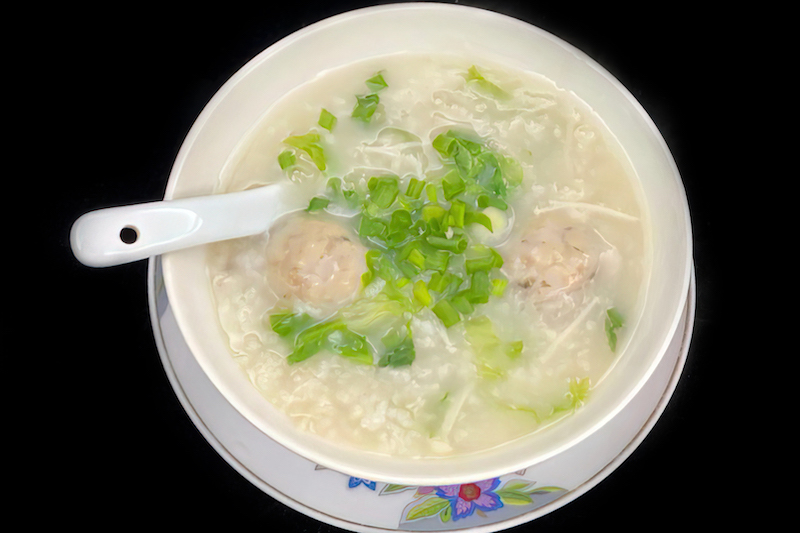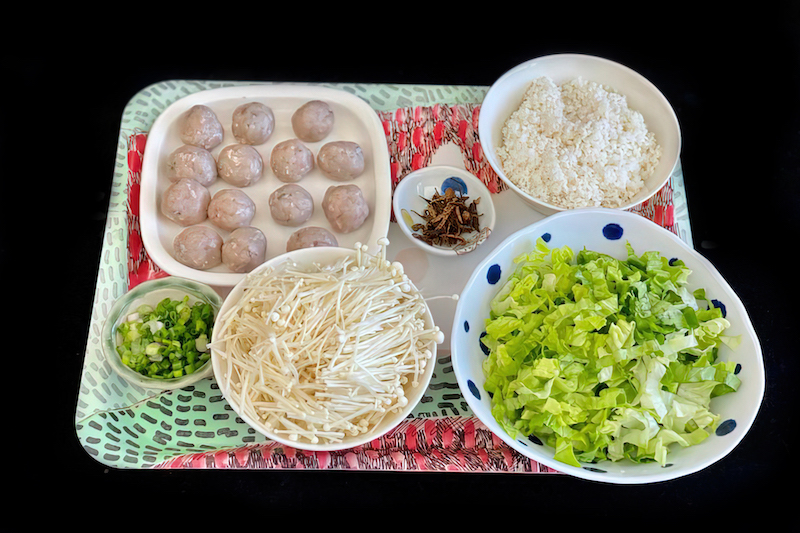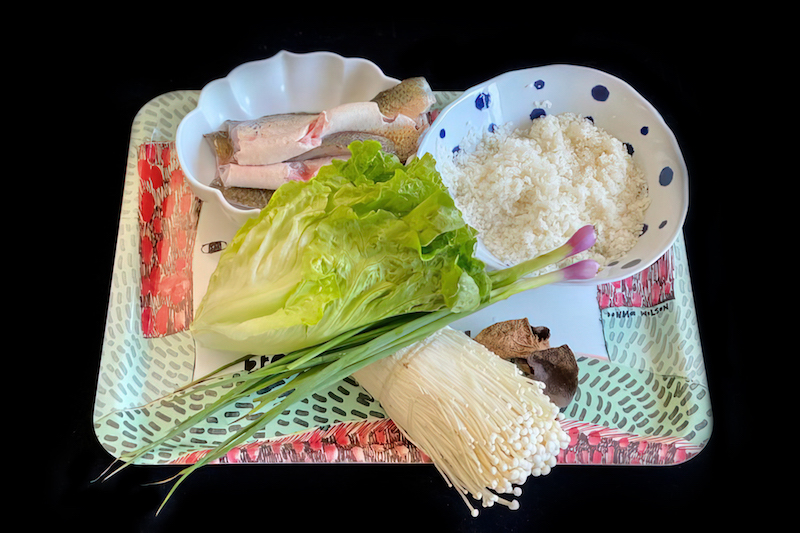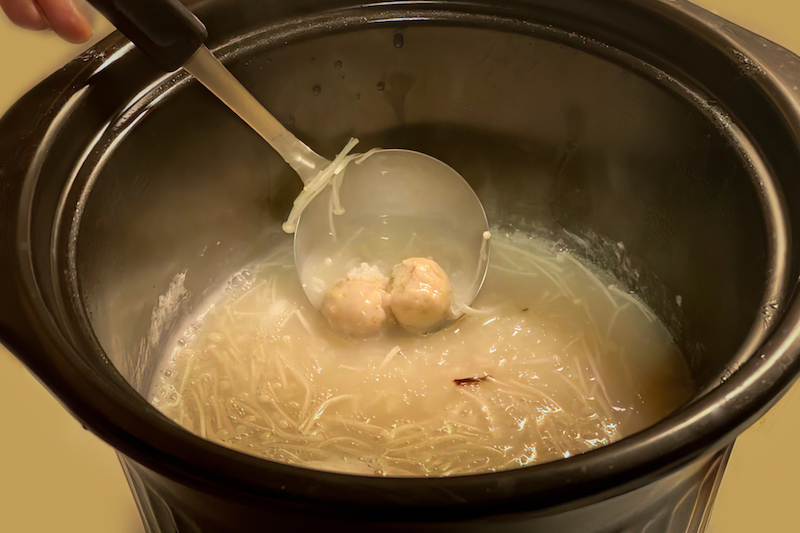金菇生菜魚滑粥
Congee with Minced Dace, Enokitake Mushroom and Lettuce

材料:(四人分量)
鯪魚肉320克
金菇2/3包
生菜8片
米120克
陳皮碎少許
葱粒少許
水12杯
熟油4茶匙
Ingredients:(4 person portion)
Dace fillet 320 g
Enokitake mushroom 2/3 pack
Lettuce 8 pieces
Rice 120 g
Finely chopped dried tangerine peel
Diced spring onion
Water 12 cups
Cooked oil 4 tsp
調味料:
鹽1茶匙
胡椒粉少許
粟粉2茶匙
Seasoning:
Salt 1 tsp
Ground white pepper
Cornflour 2 tsp
做法:
- 鯪魚肉攪碎或剁碎,加入少許鹽攪至起膠,然後拌入調味料、陳皮碎及葱粒。
- 生菜切絲;金菇切開兩段。
- 洗淨米,與清水放鍋中煮滾後,轉慢火煲約1小時至稠。
- 將鯪魚肉用湯匙做成丸狀,放入粥內煮滾,再加入金菇、生菜絲及少許鹽,翻滾。
- 最後,加熟油4茶匙便可。
Method:
- Grind up the dace in a food processor, or finely chop it. Add a little salt and stir until sticky. Add seasoning, dried tangerine peel and spring onion.
- Finely shred the lettuce. Cut enokitake mushrooms into halves across the length.
- Rinse rice and put into a pot. Add water. Bring to the boil. Turn to low heat and simmer for 1 hour until the rice is mushy.
- Shape the minced dace into balls. Put them into the congee and bring to the boil. Add enokitake mushrooms, shredded lettuce and a little salt at last. Bring to the boil again.
- Lastly add 4 tsp of cooked oil.



營養分析:(每食用分量)
能量:253卡路里
蛋白質:16.5克
碳水化合物:28.9克
脂肪:7.7克
膳食纖維:1.5克
Nutrition analysis:(per serving)
Energy:253 kcal
Protein:16.5 g
Carbohydrates:28.9 g
Fat:7.7 g
Dietary fibre:1.5 g
烹飪心得
- 加少許陳皮碎,可提升鯪魚肉的鮮味。
- 用魚骨煎煮成魚湯,加入粥內,味道更鮮美。
Cooking tips
- Add a little finely chopped dried tangerine peel to accentuate the flavour of the minced dace.
- The congee will taste better by using fish stock. To make fish stock, fry the fish bone and cook it with water.
營養學角度分析:
- 金菇及生菜為此粥品添加膳食纖維及維他命C。魚肉含豐富蛋白質,此粥品簡單易做而營養均衡。進食前添加適量熟油,可增加熱量。
中醫食療角度分析:
- 鯪魚肉:味甘,性平,無毒,入肝、腎、脾、胃經。《本草綱目拾遺》提到「健筋骨,活血行氣,逐水利濕」。它具有補中開胃、強健筋骨、活血行氣、通利小便的作用。適合脾胃虛弱、虛勞疲乏、氣血不足等人群食用,也可補益強壯,輔治黃疸型肝炎及小便不利者;陰虛咳嗽者、腹脹滿不適不宜食用。
- 金菇:味甘鹹,性涼,入脾、大腸經。具有補益肝腎、調理腸胃、益智的功效,可改善肝病、胃腸道疾病、癌症等,可增強機體正氣,防病健身。適合氣血不足、營養不良、便秘、肥胖、疲勞者多食用;金菇性涼,脾胃虛寒者不宜過多食用。
- 生菜:味甘、苦,性寒,入胃、腸經。具有清熱解毒、生津止渴、利尿通便、寬胸理氣的功效。生菜還能清除腸內毒素,防止便秘,適合經常便秘者;同時適合熱毒瘡腫、口渴、小便不利者;《四聲本草》闡述「患冷氣人食之即腹冷,亦不至苦損人。產後不可食,令人寒中,小腸痛」,因此,陽虛體質 (寒性體質) 者不宜過多食用。
- 米:味甘,性平,入脾、胃經。具有補中益氣、固腸止瀉的功效。大米煮粥可養生延年,適合病後體弱、營養不良、腹痛、腹瀉者;但糖尿病、乾燥綜合症、陰虛火旺者不宜過多食用。
- 陳皮:味辛、苦,性溫,入脾、肺經。具有理氣宜胃、燥濕化痰、健脾開胃的功效。適合胸膈滿悶、不慾進食、食少嘔吐、咳嗽痰多、小便不利、大便秘結者;不適合腹脹滿不適者。
- 葱粒:味辛,性溫。入肺、胃經。具有發汗解表、散寒通陽、防癌抗癌的功效。適合頭痛、鼻塞、流涕風寒感冒、以及陽虛體質者,氣虛自汗、濕熱體質不宜食用。
上一篇
下一篇




